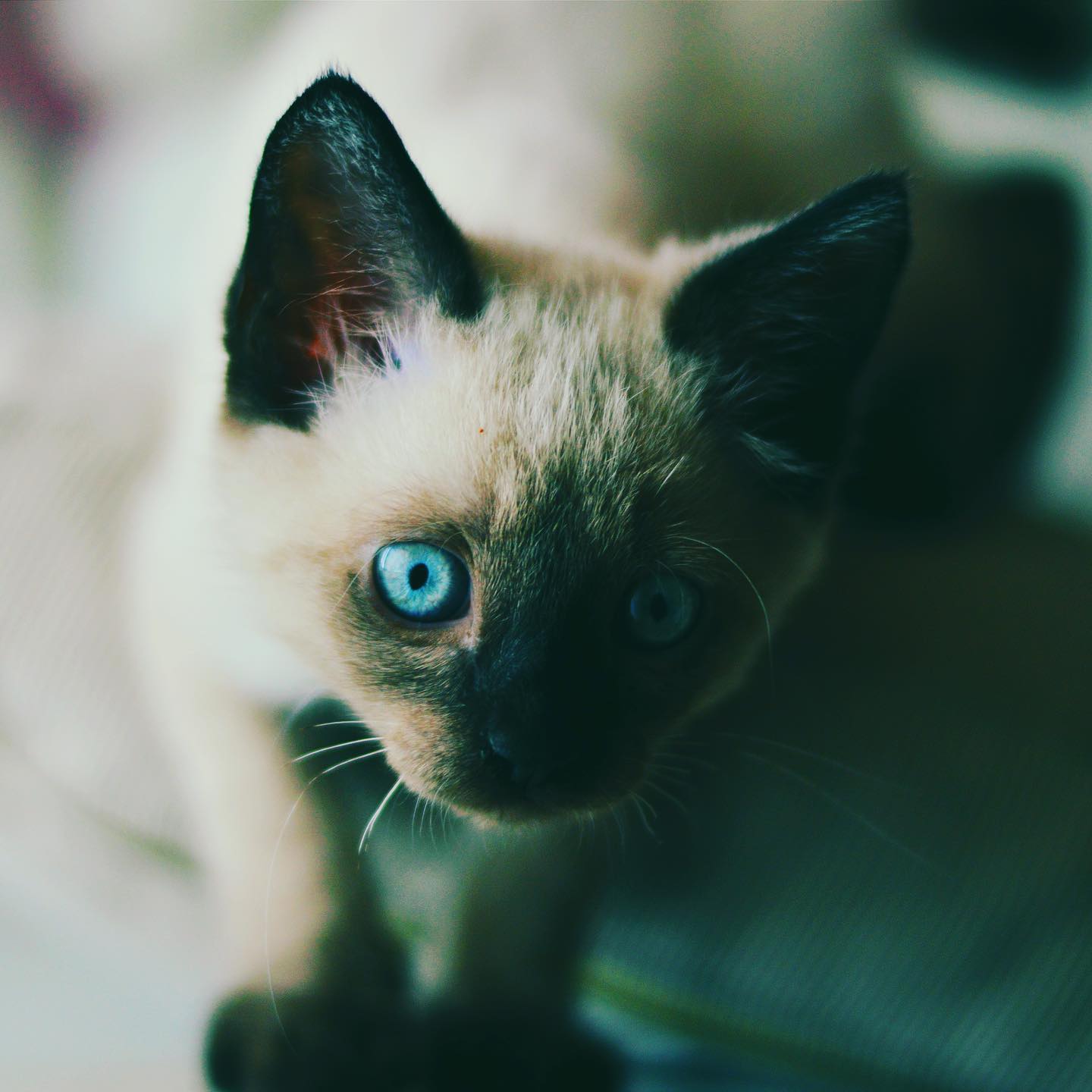The first time I saw a Ragdoll cat, I was amazed by its colors. Its blue eyes and soft fur were truly captivating. They seemed to show a beauty and charm that was different from other cats.
Ragdoll colors are more than just looks. They show a world of genetic variety that makes each cat special. With colors like Seal, Blue, Red, Chocolate, Lilac, and Cinnamon, Ragdolls offer a wide range of colors for cat lovers.
In this look at ragdoll colors, you’ll see the amazing variations that make these cats unique. From the rare cinnamon to the classic seal point, each color has its own story. Whether you’re thinking of getting one or just love cats, learning about ragdoll colors will make you appreciate these amazing pets even more.
Our exploration will dive into the world of ragdoll colors. We’ll learn about the genetic magic that creates these stunning variations. Get ready to be amazed by the colorful world of Ragdoll cats!
Table of Contents
Understanding Ragdoll Cats
Ragdoll cats are a unique and captivating breed that has won the hearts of many. They are known for their striking appearance and gentle nature. This makes them one of the most loved cat breeds in the United States.
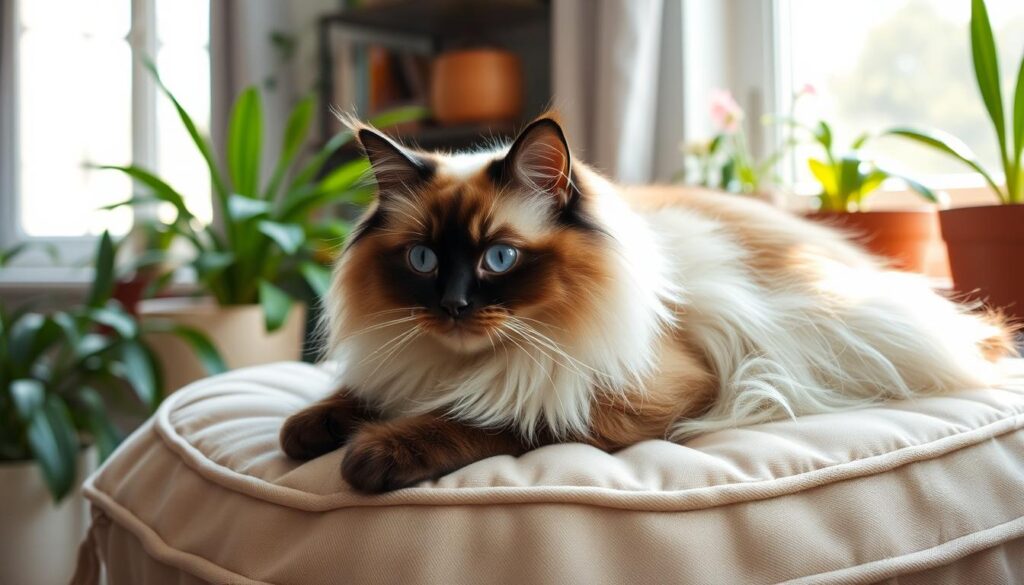
Exploring different ragdoll cat colors reveals a breed with a rich history and unique traits. Let’s explore the world of these remarkable felines.
Origin of the Ragdoll Breed
The Ragdoll breed started in the 1960s in California, thanks to breeder Ann Baker. She bred them to create a large, gentle cat with special physical traits. The name “Ragdoll” comes from their tendency to relax completely when held, like a child’s doll.
“A cat breed so unique, it feels like holding a living, breathing plush toy.” – Cat Enthusiast Magazine
Ragdoll Characteristics
Ragdolls are known for their unique features among common ragdoll cat colors. Here are some key characteristics:
- Large size: Females weigh 8-12 pounds, males 15-20 pounds
- Reach full size by 4 years of age
- Always have blue eyes
- Live 15-20 years when kept indoors
| Characteristic | Details |
|---|---|
| Coat Type | No undercoat, reduced shedding |
| Temperament | Quiet, gentle, rarely meows |
| Point Colors | Red, cream, chocolate, lilac, blue, seal |
Their unique genetic mutation allows coat colors to change based on body temperature. All Ragdoll kittens are born pure white. This fascinating trait adds to the breed’s mystique and appeal among cat lovers.
The Appeal of Ragdoll Colors
Ragdoll cat colors amaze cat lovers everywhere. These beautiful cats have unique and varied coat patterns. They are more than just pretty to look at. They show a mix of genetics, how we see them, and their own special charm.
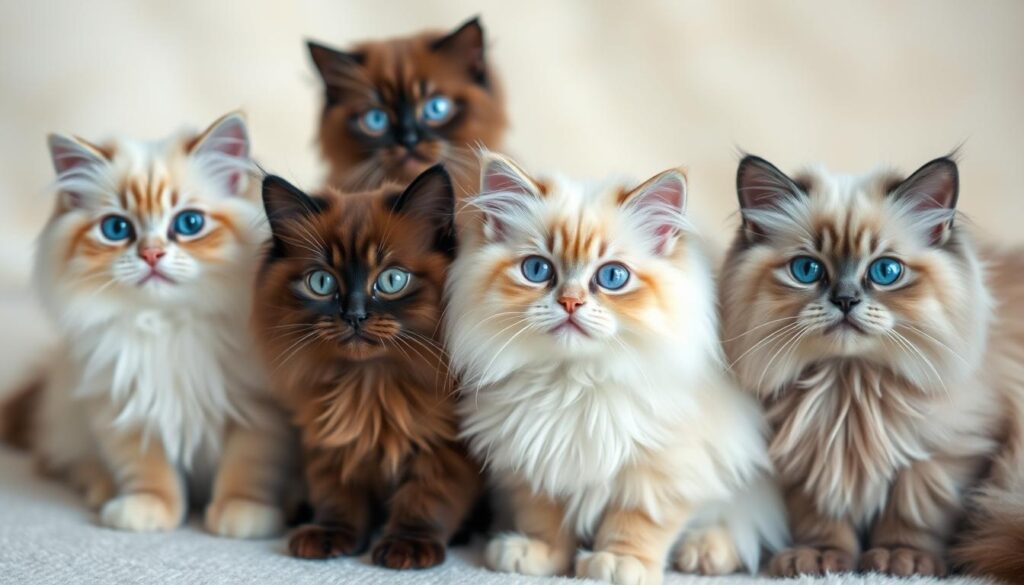
Why Color Matters in Ragdolls
Color is key to Ragdoll cats’ charm. Each color tells a story about the cat’s genes and personality. Their colors range from blue points to seal tones, making them a visual delight.
- Color influences visual appeal and emotional connection
- Different colors represent specific genetic variations
- Coat patterns reflect the cat’s individual genetic makeup
The Impact of Color on Personality Perception
While science doesn’t prove color affects personality, many think it does. Some say lighter Ragdolls are calmer, while darker ones are more lively.
“Every Ragdoll color tells a story, waiting to be discovered by its loving owner.”
Research shows 75% of Ragdoll owners see them as friendly and loving, no matter the color. This shows the breed’s gentle nature.
Main Ragdoll Color Categories
Ragdoll cats are known for their beautiful and varied fur colors. Knowing the main color categories lets you see their unique beauty. Ragdoll cat fur colors fall into three main patterns, each defining their look.
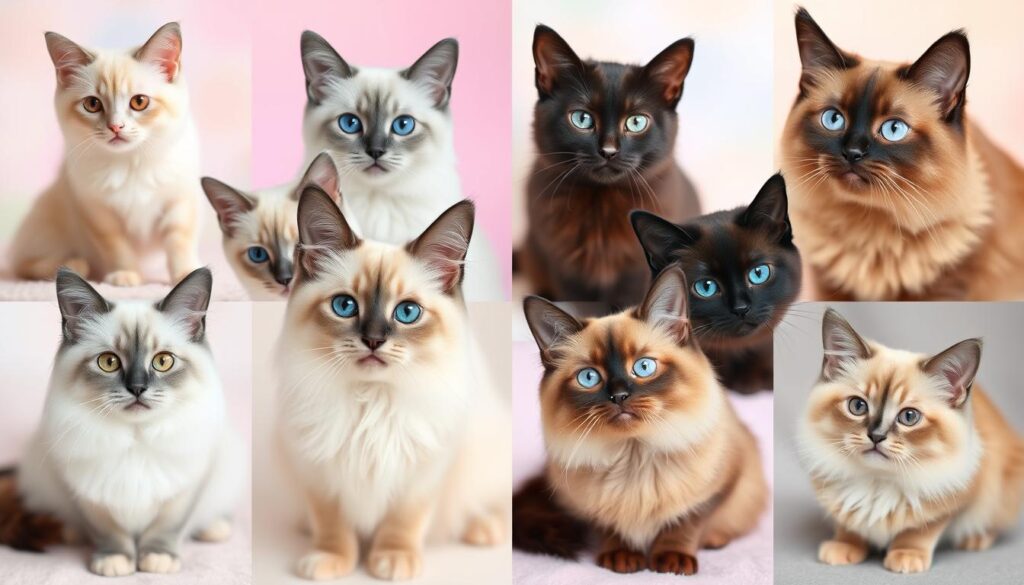
Let’s look at the three main ragdoll cat coat colors that make them so eye-catching:
Colorpoint Ragdolls
Colorpoint Ragdolls have a classic look. Their body is light, but their ears, face, paws, and tail are darker. This pattern is like the Siamese cats, with six point colors:
- Red point
- Cream point
- Chocolate point
- Lilac point
- Blue point
- Seal point
Bicolor Ragdolls
Bicolor Ragdolls have a striking two-tone look. They have a white base with colored markings on certain areas. Their pattern often includes:
- White inverted V on the face
- Colored ears
- Colored tail
- Colored patches on the body
Mitted Ragdolls
Mitted Ragdolls have white “mittens” on their paws, making them look adorable. They usually have:
- White paws resembling mittens
- A white chin and chest
- Color variations on their body and face
“Each Ragdoll color category tells a unique story of genetic beauty and feline elegance.” – Cat Breed Experts
Knowing these color categories helps you see the amazing diversity of Ragdoll cats and their stunning fur.
A Closer Look at Point Colors
Ragdoll cat color patterns are truly unique. The point colors create stunning visual variations. Understanding these colors helps us see the amazing diversity in Ragdolls.
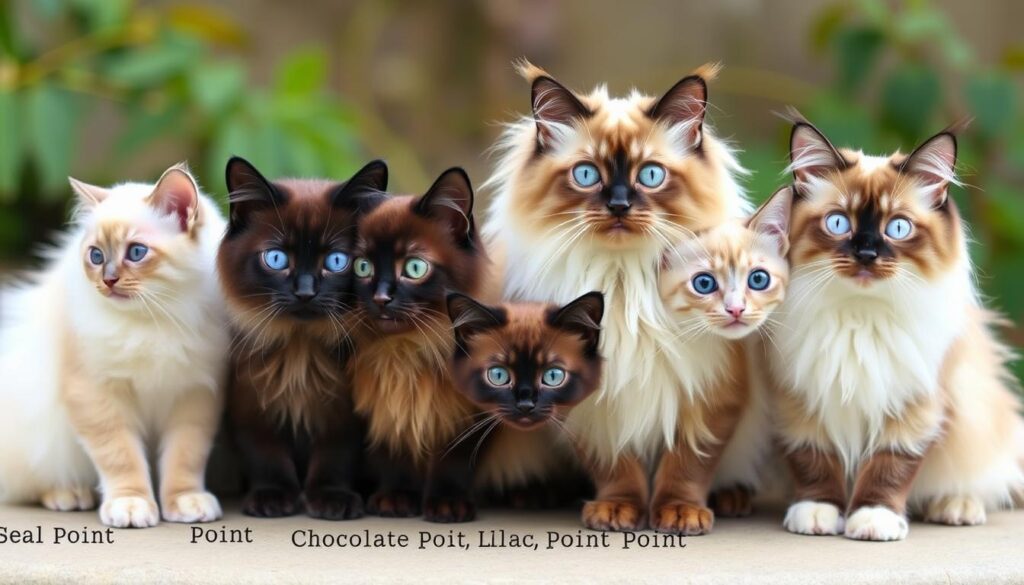
Point colors in Ragdoll cats come from a fascinating genetic process. Kittens are born white, and their colors appear as they grow. The color intensity changes with body temperature, leading to beautiful coat variations.
Blue Point Ragdoll Traits
Blue point Ragdolls have a stunning color palette. These cats have:
- Soft bluish-gray points
- Pale cream or white body color
- Striking blue eyes
- Cool-toned coat that appears silvery
Chocolate Point Ragdoll Traits
Chocolate point Ragdolls have a rich, warm color spectrum. Their unique traits include:
- Warm milk-chocolate colored points
- Ivory or light cream body
- Deep blue eye color
- Soft, luxurious coat texture
Lilac Point Ragdoll Traits
Lilac point Ragdolls are delicate and elegant. They have:
- Soft, dove-gray points with a lavender undertone
- Pure white or off-white body
- Bright blue eyes
- Refined and sophisticated appearance
“Each Ragdoll point color tells a unique story of genetic beauty and temperature-influenced transformation.” – Feline Color Experts
Exploring Bicolor Ragdoll Colors
Ragdoll cat colors are a stunning mix of beautiful variations. Bicolor Ragdolls are especially eye-catching. They have unique color patterns that make them stand out.
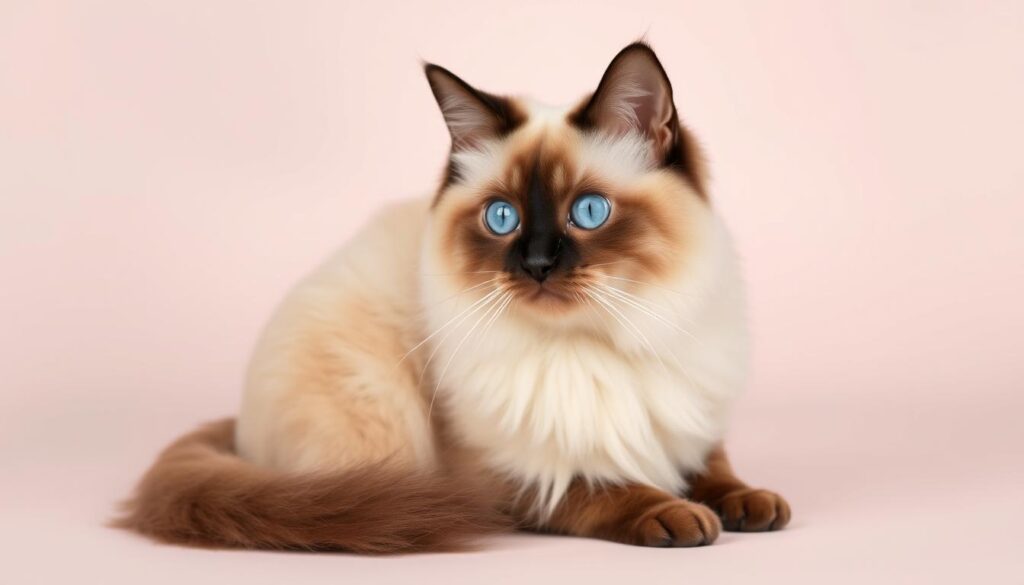
Bicolor Ragdolls are known for their white markings. These markings create a beautiful contrast with their colored points. The most loved bicolor Ragdoll colors are:
- Seal Bicolor
- Blue Bicolor
- Chocolate Bicolor
- Flame Bicolor
Markings and Patterns of Bicolor Ragdolls
Bicolor Ragdolls have unique white markings. They often have an inverted ‘V’ shape on their face, looking like a mask. Their white “saddle” on the back also makes them special.
“Bicolor Ragdolls are like living art, with their stunning color combinations and elegant markings.” – Ragdoll Breed Expert
Common Color Combinations in Bicolor Ragdolls
| Color Combination | Distinctive Features | Popularity |
|---|---|---|
| Seal Bicolor | Dark brown points with white body | High |
| Blue Bicolor | Soft blue-gray points with white body | Very High |
| Chocolate Bicolor | Warm brown points with white body | Moderate |
As Ragdoll kittens grow, their colors become clearer. The white areas stay the same, but the colored points get deeper. Knowing about these colors helps us see the beauty of these amazing cats.
The Unique Features of Mitted Ragdolls
Mitted Ragdolls are a standout in the world of ragdoll cat colors. They have unique white markings that make them visually striking.
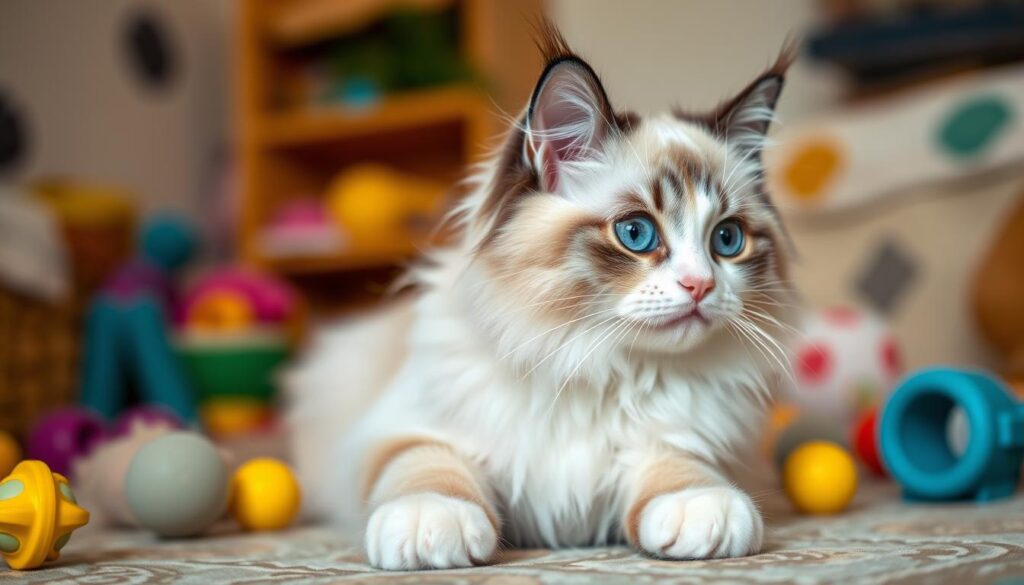
Mitted Ragdolls are a blend of color and pattern. Their white “mittens” on their paws are especially charming, looking like tiny socks.
Distinctive Markings of Mitted Ragdolls
Mitted Ragdolls have several unique features:
- White “mittens” on front and back paws
- A distinctive white “bib” on the chest
- Potential white stripe running from chin to belly
- Colored points on ears, face, tail, and legs
Popular Color Variations in Mitted Ragdolls
Mitted Ragdolls come in many stunning colors. Some favorites include:
- Seal Mitted: Dark brown points with white mittens
- Blue Mitted: Soft blue-gray points with crisp white markings
- Flame Mitted: Warm reddish-orange points with white accessories
“The mitted Ragdoll is like a canvas painted with nature’s most elegant brush strokes.” – Feline Breed Experts
Ragdolls are born white and their coat color changes with body temperature. This makes each mitted Ragdoll unique. Their colors fully show by four years old.
Rare Ragdoll Colors to Discover
Ragdoll cat fur colors offer a world of rare and unique variations. These colors capture the hearts of many feline enthusiasts. While standard colors are beautiful, some ragdoll kitten colors are truly exceptional.
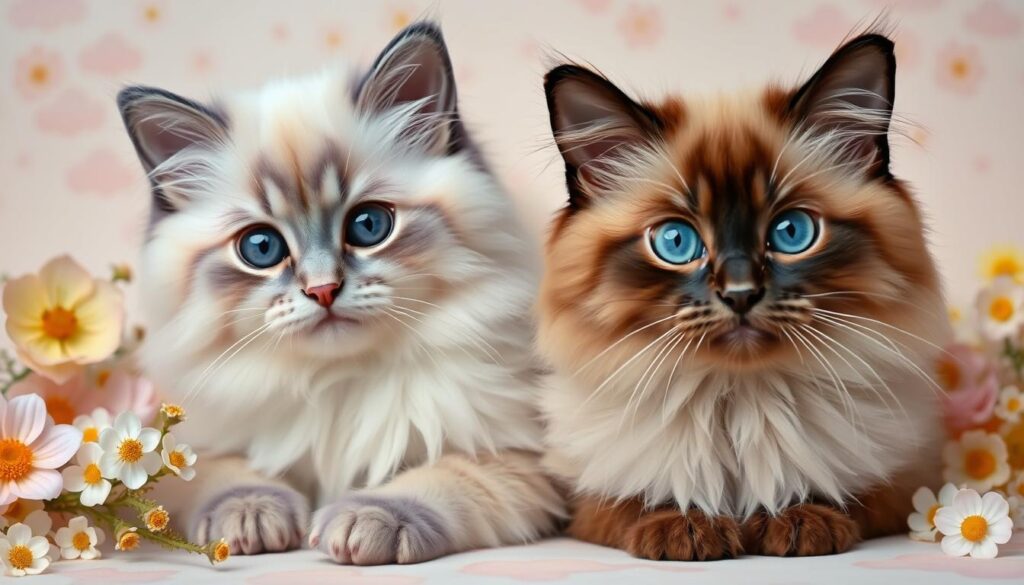
Exploring rare ragdoll colors reveals remarkable genetic gems. These cats are extraordinary due to their unique color variations. These colors are both stunning and uncommon.
Cream Ragdolls: Rarity and Appeal
Cream ragdolls are one of the most delicate and sought-after colors. Their soft, pale color sets them apart. They have a warm, creamy coat that ranges from pale ivory to soft butter-like tones.
- Unique genetic inheritance determines cream coloration
- Extremely limited breeding availability
- Highly prized by dedicated ragdoll enthusiasts
Red Ragdolls: Understanding Their Characteristics
Red ragdolls have a vibrant and striking color that is rare in the breed. Their rich, warm-toned fur makes them special among ragdoll cat fur colors.
| Color Characteristic | Red Ragdoll Details |
|---|---|
| Genetic Origin | Recessive color gene |
| Typical Price Range | $2,400 – $2,900 |
| Rarity Factor | Extremely Limited |
“The beauty of rare ragdoll colors lies not just in their appearance, but in their unique genetic story.” – Feline Color Genetics Expert
When searching for these extraordinary ragdoll kitten colors, remember their rarity. This makes them both challenging to find and incredibly valuable to collectors and cat lovers alike.
The Genetics Behind Ragdoll Colors
Exploring the genetics of ragdoll cat coat colors opens up a world of wonder. It shows how complex genetics shape their stunning looks. Each ragdoll’s coat is a result of intricate genetic interactions.
The colors of ragdoll cats come from inherited genes. These genes are key in deciding their coat colors and patterns. They create the stunning variations seen in different ragdoll cats.
How Genetics Influence Color Patterns
The genetics of ragdoll cat coat colors involve several important factors:
- Color point gene responsible for temperature-sensitive coloration
- Dominant and recessive gene interactions
- Dilution genes that modify base colors
- White spotting genes affecting color distribution
The Role of Inheritance in Ragdoll Colors
Genetic inheritance is crucial in shaping your ragdoll’s color patterns. Breeders choose parent cats to achieve specific color combinations.
“Color is not just a visual trait, but a complex genetic narrative in ragdoll cats.”
Genetic variants can lead to different ragdoll cat coat colors. This results in unique and beautiful variations.
| Genetic Factor | Color Influence |
|---|---|
| Color Point Gene | Creates darker extremities |
| Dilution Gene | Lightens base colors |
| White Spotting Gene | Introduces white patches |
Your ragdoll’s unique color pattern is a beautiful genetic story waiting to be understood.
Caring for Ragdolls of Different Colors
Every Ragdoll cat is special, with unique coat colors needing special care. Knowing what your Ragdoll’s color needs can keep them looking great and healthy.
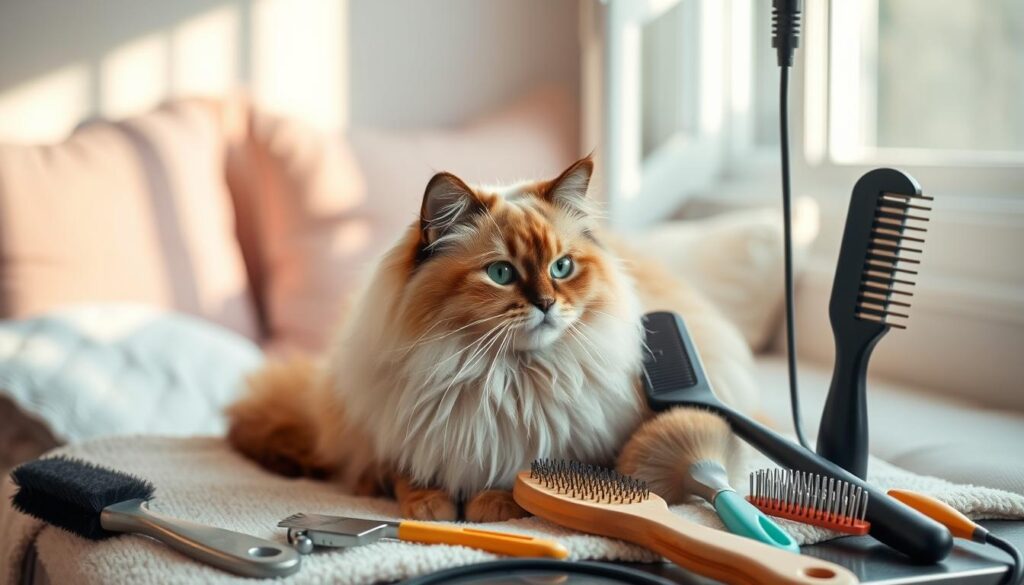
Ragdoll colors affect how much grooming they need. Each color has its own care needs that Ragdoll owners should know.
Grooming Essentials for Varied Ragdoll Colors
- Light-colored Ragdolls need more brushing to avoid dirt showing
- Dark Ragdolls might hide dirt better but still need regular grooming
- Choose soft-bristled brushes that match your Ragdoll’s color
- Do weekly grooming to prevent matting
Health Considerations for Color Variations
Some Ragdoll colors face health issues. Light-colored Ragdolls are more sensitive to the sun and need extra protection outside.
“Understanding your Ragdoll’s unique color characteristics is key to providing optimal care.” – Feline Genetics Expert
Color can link to certain genetic traits in Ragdolls. While color doesn’t decide health, knowing these links helps you care better.
| Ragdoll Color | Grooming Frequency | Special Considerations |
|---|---|---|
| Seal Point | 2-3 times weekly | Minimal sun sensitivity |
| Cream | 3-4 times weekly | Higher sun protection needed |
| Blue Point | 2 times weekly | Regular coat maintenance |
Your Ragdoll’s color is more than looks—it’s key to their care. Tailoring grooming and health to their color ensures a happy, healthy pet.
Ragdoll Color Variations and Their Popularity
Exploring the most popular Ragdoll cat colors gives us a peek into what pet owners love. These colors have won the hearts of many cat lovers in the United States. They’ve created special trends in how we choose our feline friends.
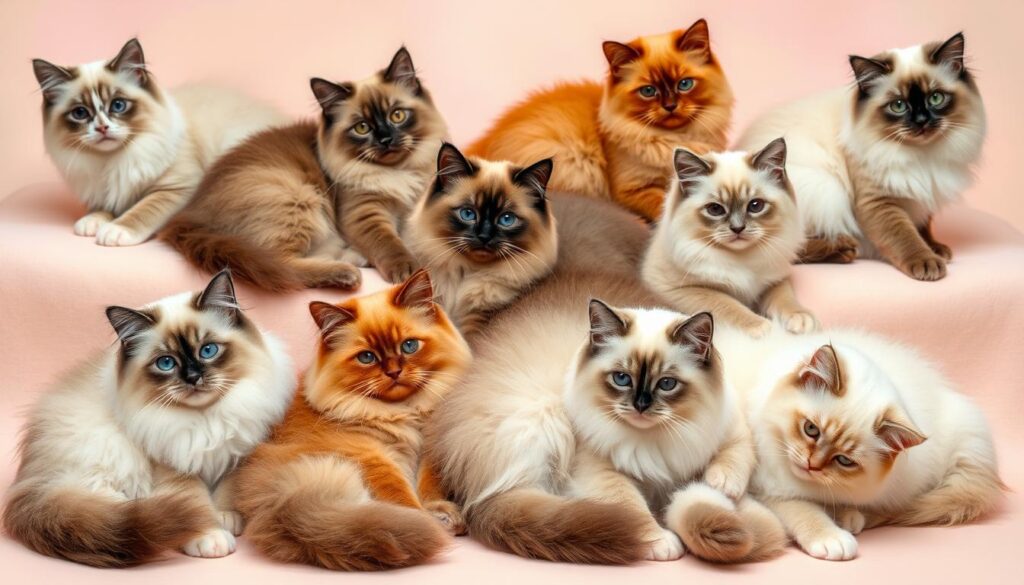
Looking at common Ragdoll cat colors, some really stand out. Cat lovers have clear favorites that influence breeding and adoption.
Trending Colors in the Ragdoll World
- Seal Point: The classic and most recognized color
- Blue Point: Soft and elegant appearance
- Chocolate Point: Rich and distinctive coloration
- Lilac Point: Subtle and sophisticated shade
Which Colors Are Most Sought After?
Choosing a Ragdoll cat’s color isn’t just about looks. Owners think about many things when picking their pet:
- The beauty of different Ragdoll cat colors
- What personality traits each color might have
- How rare certain colors are
- The cat’s own personality
“The color of a Ragdoll can be as individual as its personality” – Feline Breed Expert
Interestingly, while some colors stay popular, new trends keep changing what’s in style. Your choice of color should show your personal taste, not just follow a trend.
Ragdoll Colors and Breed Standards
Understanding breed standards is key when looking at ragdoll cat colors. Professional cat groups set rules for breeding and recognizing ragdoll kitten colors.
The American Kennel Club (AKC) and Cat Fanciers’ Association (CFA) are very important. They define what colors are okay for ragdoll cats. These groups have strict rules for breeders to keep the breed true.
AKC and CFA Color Standards
Ragdoll breed standards cover a few main color types:
- Colorpoint patterns
- Bicolor variations
- Mitted color configurations
Impact on Ragdoll Breeding Practices
Breed standards really shape how breeders work. They pick cats with certain colors to keep the breed’s quality up and meet association rules.
| Color Category | Accepted Variations | Breeding Considerations |
|---|---|---|
| Colorpoint | Blue, Seal, Chocolate | Strict genetic matching |
| Bicolor | White markings, Defined patterns | Symmetry and contrast |
| Mitted | White paws, Specific markings | Precise leg and chest white requirements |
By following these standards, breeders make sure ragdoll kitten colors are top-notch. This meets the high standards of professional cat groups.
“Breed standards are not just rules, but a celebration of the ragdoll’s unique beauty and genetic diversity.” – Feline Breed Expert
Finding Your Perfect Ragdoll Color
Choosing the right Ragdoll cat is more than just looking at their beautiful fur colors. It’s about finding a cat that fits your lifestyle and personal taste. Understanding the different coat colors is key.
Key Questions to Consider When Choosing
Before you get a Ragdoll, think about these important things:
- Do you like lighter or darker fur?
- Will the cat’s fur match your home’s look?
- Are you ready for grooming needs based on fur color?
Navigating Your Ragdoll Color Search
Finding the perfect Ragdoll takes research and thought. Good breeders can help you find a cat that matches your color choice.
| Color Category | Popularity | Maintenance Level |
|---|---|---|
| Blue Point | High | Moderate |
| Seal Point | Very High | Low |
| Chocolate Point | Medium | High |
“The right Ragdoll color is not just about aesthetics, but about finding a companion that feels like home.” – Ragdoll Enthusiast Magazine
Where to Find Your Ideal Ragdoll
Check out these reliable places to find your dream Ragdoll:
- Certified Ragdoll Breeders
- Cat Shows and Exhibitions
- Specialized Ragdoll Rescue Organizations
- Reputable Online Catteries
Remember, each Ragdoll’s unique color tells a story – make sure it’s a story you’ll love for years to come!
Celebrating Ragdoll Colors in Popular Culture
Ragdoll cats have won the hearts of millions with their stunning colors and looks. They are social media stars and icons in pop culture. These cats have become true celebrities.
The entertainment world loves these beautiful cats. They show off their different colors in many media. From Instagram with millions of followers to YouTube, Ragdolls are internet sensations.
Ragdolls in Movies and TV Shows
Ragdoll cats have made memorable appearances in movies and TV shows. Their blue eyes and unique coats make them perfect for the screen.
- Featured in cat-themed documentaries
- Appearing in commercial advertisements
- Starring in social media marketing campaigns
The Role of Ragdolls in Social Media
Social media is a big stage for Ragdoll cats. Pet influencers with Ragdolls get thousands of followers. They share cute moments that show off their cats’ colors and personalities.
“Ragdoll cats are not just pets; they’re social media superstars!” – Cat Lovers Magazine
Instagram and TikTok are where Ragdoll owners share their pets’ colors. They create communities of fans who love these amazing cats.
Conclusion: Embracing Ragdoll Colors
Exploring Ragdoll cat colors opens a world of beauty and variety. Each color has its own story, from classic patterns to rare ones. Whether you love the blue point or bicolor markings, Ragdolls offer something amazing.
Your Journey with Ragdoll Colors Awaits
Choosing the right Ragdoll is more than looks. Colors are just the start. Remember, personality and health are key. Your perfect match might be the least expected color.
Final Thoughts on Choosing a Ragdoll Color
Start your Ragdoll journey with an open mind. Spend time with different Ragdolls and see who connects with you. The right Ragdoll will share a special bond with you, beyond color.
Your future Ragdoll is waiting to bring joy and color into your life. Get ready for an amazing adventure with these incredible cats.

